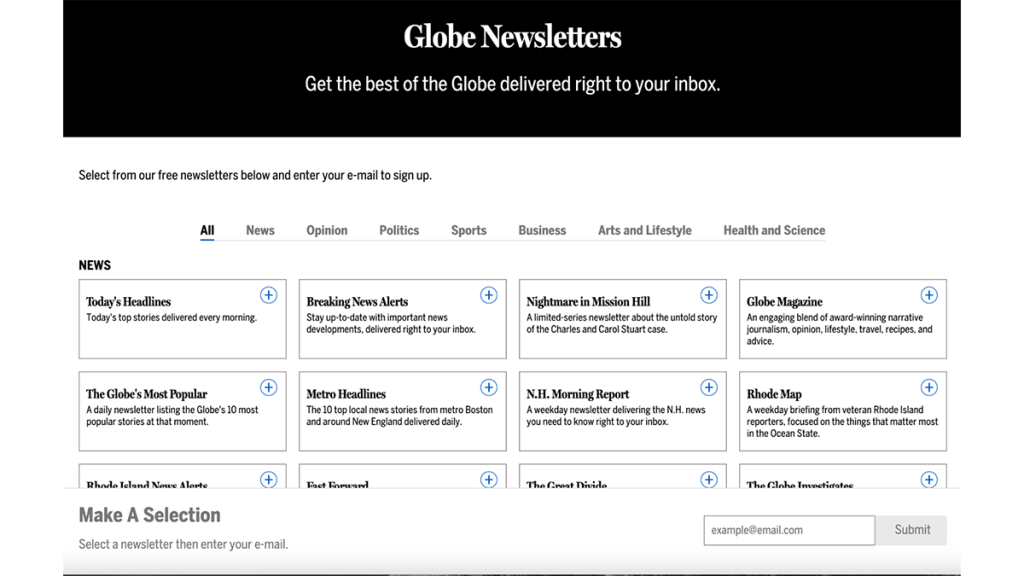
Lean into what your core audiences value
A conversation with Jacqué Palmer, The Boston Globe on growing your newsletter

As senior editorial director for newsletters at The Boston Globe, Jacqué Palmer manages the organization’s entire newsletter portfolio — from design and content to promotion and experimentation. She works closely with editorial leadership to make sure the newsletters align with the newsroom’s goals and editorial priorities. And she isn’t afraid to try something new.
This month the Innovation in Focus team spoke with Palmer about how she experiments in newsletters – especially when it comes to growing audience — and how smaller newsrooms can build that culture of experimentation within their budget and staffing limits.
Dolan: What kinds of strategies do you consider when you’re talking broadly about growth in newsletters?
Palmer: I always want to make sure that whatever I’m considering is data-informed. Knowing who your audience is and being able to say, “okay, this is who I’m talking to.” What language is familiar to them? Where can I meet them where they are? What mobile device are they using? That’s information that I really love to look into. Where in their day are they most primed to sign up for a newsletter? And I work across departments to find the best opportunities for presenting a sign-up or a call-out for a newsletter.
Dolan: How do you collect data and measure the experiments?
Palmer: I gather data from a couple of different sources. I’ve used everything from Looker, Google Analytics, Tableau, Salesforce ExactTarget, Mailchimp campaign reports, send reports, deliverability reports, unsubscribe rates, opens, replies to surveys and replies on social platforms. My number one thing is to always look at everything holistically. I’m always going to be considering a variety of metrics when I’m looking to test something.
Dolan: Do you have any tips or tools that help you when managing data?
Palmer: I always have to weigh the cost-benefit of spending a lot of time learning a new tool. Good old Google Sheets, CSV files are your friend. Pivot tables are your friend. Learn how to export and import CSV files into Sheets, sort them and filter them by the information that you need. Are you just looking for open rates? Are you looking to sort by zip code? Are you looking to sort by click rate? That helps you get rid of low performing things, and then you can take a more nuanced look into what’s really performing and what’s moving things for your portfolio. Having an analytics team also goes a very long way, and I wish that for every single newsroom to have someone whose job it is to look into the data and provide context for you.
Dolan: How do you know that an idea is worth a newsletter product?
Palmer: I have a one-pager that I have people fill out: What are your goals? Who is the audience? The audience is so important for newsletters. If your audience skews very young, that’s probably not a good play here because email is not part of their daily behavior. Maybe a TikTok series or a texting series is a better play for this. The audience is super essential to whether we move on to the next step in a newsletter product, also prioritizing what I have on my plate and what the newsroom has set as editorial priorities.
On the flip side of that, if we as a newsroom have said that these are some really important communities that we need to be serving, but they might not be big email consumers, we might do it anyway and find ways to make it more accessible for them. I would just put on my marketing hat and start thinking about more grassroots ways that we can meet people where they are, like putting QR codes everywhere or providing free access in print. So it really does depend.
Dolan: How do you go about building the habit of experimentation and making it a consistent thing?
Palmer: You yourself, as a leader, need to foster a culture of generous collaboration and of team building and of skill sharing. If you don’t care to lift others up or cross-train your teams and departments, it just really gets in the way of being a more nimble and successful team. And you need to hire smartly. Hire more creative people, more people rooted in empathy, people that really want to not just do great work but also build great teams, lift as they rise. It truly does take a community to make this happen. And if you’re in a newsroom where everybody just thinks about their own thing, it can be very hard to be successful.
Dolan: What recommendations would you have for smaller organizations that might be trying to institute new things?
Palmer: I’m very much about investing. Investing in an email team, investing in some kind of email producer. Because most email folks are actual product managers. So if you have the budget, see if you can find an email consultant with experience in newsroom newsletter strategy to come in and do some trainings and help you build a better workflow for your team. But if that’s not possible, I would probably start with your breaking news team. If there’s someone that’s interested in email, give them ownership of onsite experimentation. Give them some goals. I use Airtable to keep myself on track, and I also have an editorial promotional calendar on Gmail to let other people know what’s testing and what’s in queue. You can pinpoint a web producer or a producer on the breaking news team who is interested in email and maybe incentivize them to explore innovation. But really my answer is to invest.
Dolan: What are some things of value that a newsroom can offer to authentically incentivize people to subscribe?
Palmer: Being of service to them, making change and reporting on things that are happening in the community. They see that you have reached out to them. You have asked them for their feedback. You have then continuously reported on that. You have then followed up with them with a direct mailer, saying: You told us this. We did this. Here is the impact. Do you think that is worth a subscription? You have to just tell the story. But also, really, it’s just adding value. Merchandise is just merchandise, right? That’s not going to convert someone long term. It’s usually the content; the hard-hitting, investigative series, even the light food coverage, the daily joys of life, that people really crave more of. Highlight that stuff. Highlight the human condition. Because people want to support that with their dollars.
Dolan: Is there any other advice you could offer newsrooms who might want to try more experimentation?
Palmer: Lean into what is distinctly you, what your core audiences are saying they value and they remain subscribers for. Also be mindful of the audiences that you are not reaching but that your current subscribers are subsidizing the cost for — which is very important. Serve them and also remind those subscribers, “Hey, you know, you’re subsidizing the cost for these communities that can’t afford a subscription but also deserve to have access to this information for the support of our democracy.” I think the storytelling aspect of it is so important. Lean into what you know.
Editor’s Note: This interview has been edited for clarity and brevity.

Sign up for the Innovation in Focus Newsletter to get our articles, tips, guides and more in your inbox each month!
Cite this article
Dolan, Olivia (2024, April 15). Lean into what your core audiences value. Reynolds Journalism Institute. Retrieved from: https://rjionline.org/news/lean-into-what-your-core-audiences-value/

Comments